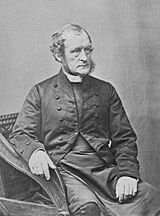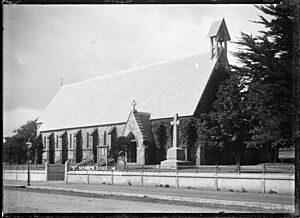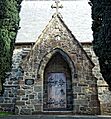Taranaki Cathedral facts for kids
Quick facts for kids Taranaki Cathedral |
|
|---|---|
| The Taranaki Cathedral Church of St Mary | |

Taranaki Cathedral Church of St Mary
|
|
| 39°03′37″S 174°04′23″E / 39.060271°S 174.073080°E | |
| Country | New Zealand |
| Denomination | Anglican |
| History | |
| Former name(s) | St Mary's Church (1842 – 2010) |
| Status |
|
| Founder(s) | George Selwyn |
| Consecrated | 6 March 2010 (as a cathedral) |
| Events | 2011 Christchurch earthquake |
| Architecture | |
| Functional status | Closed for repairs (2016) |
| Architect(s) |
|
| Architectural type | Church |
| Style | Gothic Revival |
| Years built | 1845–1846 |
| Closed | 2016 |
| Specifications | |
| Materials | Stone |
| Administration | |
| Diocese | Waikato and Taranaki |
| Province | Anglican Church in Aotearoa |
The Taranaki Cathedral Church of St Mary is a very old and important Anglican church in New Plymouth, New Zealand. It used to be called St Mary's Church.
This cathedral is special because it is the oldest stone church in all of New Zealand. It is also listed as a Category 1 Historic Place by Heritage New Zealand, which means it's a really important historical building. Even though it's old, it became a cathedral quite recently, in 2010. It is the main church for the Bishop of Waikato and Taranaki, Bishop Philip Richardson.
The first part of the church was built between 1845 and 1846. It was designed in the Gothic Revival style by Frederick Thatcher, an architect from London who was one of the first people to settle in New Plymouth. The cathedral was closed in February 2016 for repairs after a big earthquake in Christchurch in 2011. It is still closed for these repairs.
Contents
History of the Cathedral
New Plymouth was chosen as the second European settlement in New Zealand. People started arriving there in 1841. The settlers wanted to have churches like the ones they had back home. They also wanted to share Christianity with the Māori people. Most of the settlers belonged to the Church of England. So, a group called the Church Mission Society helped to appoint a Bishop for New Zealand. This bishop's job was to set up the Anglican church in the new Diocese of New Zealand. This diocese covered the whole country and even some islands in Polynesia.
In 1841, George Augustus Selwyn became the first Bishop of New Zealand. He arrived in New Zealand in 1842 and started his work.
Building the First Church
After visiting New Plymouth in October 1842, Bishop Selwyn decided to build churches there. He chose Reverend William Bolland to be the Deacon for New Plymouth. He also got in touch with Frederick Thatcher, a skilled architect from London. Thatcher arrived in New Plymouth in 1843 and was very important in designing many Gothic Revival churches in New Zealand.
Bishop Selwyn provided the money, and Reverend Bolland and Frederick Thatcher began building two new churches. These were St Mary’s Church in central New Plymouth and the Holy Trinity Church at Henui.
The first stone for St Mary's was laid on March 23, 1845. Stone masons Thomas Rusden, Harry Hooker, and Phillip Moon built the church in just 18 months. They used stones that they brought from the beach. George Robinson, the main builder, was responsible for the beautiful roof, which was made from rimu wood.
The original part of St Mary's was built between 1845 and 1846. It was about 15 meters long and 9 meters wide. It had rough stone walls, wooden beams that you could see, a steep rimu roof, and tall, narrow windows with pointed arches.
St Mary's During Conflicts
During the First Taranaki War and Second Taranaki War, St Mary’s Church became more than just a place of worship. It was used as a safe place, almost like a fort. The churchyard was even used to keep cattle. For a while, the church also stored ammunition and explosives.
Soldiers stayed in the west part of the church, where new sections were being built. These new parts even had holes for muskets. When people thought the town might be attacked, a naval force was placed inside the church. Women and children often gathered inside the church for safety during these times.
Church Enlargements
Over the years, the church has been made much bigger and changed a lot. All the new parts blend together nicely. The first additions to St Mary's were made during the war years. In 1859, the church was made longer, and a veranda was added. However, because of the fighting, this work was not finished until 1862. In 1864, another aisle was added next to the existing building. This was designed by George Robinson, who was the main builder of the original church.
More additions were made in 1893 to the chancel, apse, sanctuary, and organ area. These were designed by Benjamin W. Mountfort, a famous church architect. In 1915, the side chapel of All Saints was added. This was designed by John Francis Messenger, a local architect. At the same time, the northern transept was made larger as a memorial to Archdeacon Govett.
St Mary's was a regular parish church from 1842 until 2010. On March 6, 2010, it was officially made a cathedral for the Diocese of Waikato and Taranaki. On June 28, 1984, the building was recognized as a Category 1 heritage building by the New Zealand Historic Places Trust (now Heritage New Zealand).
The cathedral is part of the Community of the Cross of Nails. This means it is a special place that works for peace and bringing people together.
Recent Closure for Repairs
In February 2016, the Cathedral was closed. This happened after experts checked its structure following the 2011 Christchurch earthquake. Sunday church services have been held in the Peace Hall across the road since then.
The cemetery next to the church has the graves of important people. These include Reverend William Bolland, who opened the church, and Reverend Henry Govett, the second vicar. It also has the grave of Captain Henry King, a Resident Magistrate, and other important historical figures.
Near the entrance to the cathedral, there is a memorial for soldiers from the South African War. It is a Celtic Cross design and was shown to the public on August 27, 1903.
Leaders of the Cathedral
The Dean is the main priest who leads the cathedral. Here is a list of the Deans of Taranaki Cathedral:
- 2010–2016: Jamie Allen
- 2016–2018: Peter Beck
- 2018: Ross Falconer
- 2018–2020: Trevor Harrison
- 2020–2021: Jacqui Patterson and Jay Ruka
- 2022–present: Jay Ruka
Images for kids









